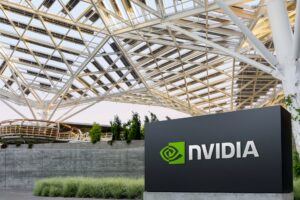Meta Platforms continues to grow at a breakneck pace.
The “Magnificent Seven” — Apple, Microsoft, Nvidia, Alphabet (GOOGL 1.01%) (GOOG 0.95%), Amazon, Meta Platforms (META 1.60%), and Tesla — have captured the spotlight this earnings season. And for good reason — the group has been instrumental in leading the market higher in 2023 and 2024.
After blowing analyst earnings estimates out of the water, Meta Platforms surged as high as 11% on Aug. 1 — only to give up most of those gains by close on Aug. 2 as a widespread sell-off in mega-cap growth stocks rippled through markets.
A weak unemployment report and Amazon’s disappointing guidance were some of the catalysts driving the broader market sell-off. And although some investors may be tempted to buy the dip on Amazon, Meta looks like an even better growth stock to buy now.

Image source: Getty Images.
Meta’s impressive numbers
Compared to the same quarter in 2023, Meta’s revenue surged 22%, the operating margin was 38% compared to 29%, and net income jumped 73%. Meta continues to justify price increases, with ad impressions up 10% across its Family of Apps and average price per ad also up 10%. Daily active people across its apps was 3.27 billion for June 2024, increasing 7%.
Meta narrowed its third-quarter revenue guidance to a range of $38.5 billion to $41 billion. For context, third-quarter 2023 revenue was $32 billion — meaning the midpoint of its guidance would be a 24% year-over-year increase. That’s a significant acceleration compared to the 11% revenue jump between Q3 2022 and Q3 2023.
Meta expects full-year capital expenditures to be $37 billion to $40 billion — up from its prior range of $35 billion to $40 billion. “While we continue to refine our plans for next year, we currently expect significant capital expenditures growth in 2025 as we invest to support our artificial intelligence [AI] research and product development efforts,” said Meta in its earnings release.
Overall, Meta is growing its top line and expanding margins, and expects to accelerate spending to fuel growth.
Full steam ahead
In a relatively short amount of time, Meta adjusted to the threat of TikTok — which in hindsight was probably a net positive for Meta, because it led to innovation and better monetization through Reels and other improvements. Meta has transformed itself into about as close to a perfect business as you can get. It has a dominant position across its apps. It is growing operating income faster than sales, which has led to margin expansion. And that’s despite losing billions on Reality Labs each quarter.
Reality Labs refers to the company’s other investments, like Ray-Ban Meta Smart Glasses, virtual reality headsets, and more. For the six months ended June 30, Reality Labs brought in $793 million in sales and had an operating loss of $8.33 billion, whereas the Family of Apps had revenue of $74.73 billion and earned $36.999 billion in operating income.
Without being weighed down by Reality Labs, Family of Apps would have an operating margin of nearly 50% — which is wildly impressive.
The losses on Reality Labs would be inexcusable at just about any other company. But Meta can afford it — which is a testament to the strength of Instagram, Facebook, and WhatsApp.
Meta’s Family of Apps performance is so strong that the company can afford to accelerate its spending, buy back stock, and pay a dividend.
Meta’s research and development (R&D) expense is up more than three-fold in the last five years, which has outpaced the growth of operating income and revenue.
As you can see in the following chart, Meta is converting nearly a third of revenue into net income, while supporting growing capital expenditures and a massive buyback program that is roughly six times the size of its dividend expense.
META Revenue (TTM) data by YCharts.
To top it all off, Meta has an impeccable balance sheet — finishing the quarter with $32.05 billion in cash and cash equivalents and $26.04 billion in marketable securities, compared to just $18.39 billion in long-term debt.
Widening the lead
When a company is producing lights-out results, it’s easy to get enamored by the numbers. While Meta deserves a lot of credit for its results, and attention should go toward the financials, it’s also important to think about the big picture.
Meta is not just doing well now — it’s laying the foundation for sustained growth. It is one of the best examples of a company that is aggressively investing in AI and making those investments pay off. Meta has developed AI tools to help with content creation and engagement with followers, make purposeful ads, and deliver accurate analytics. At its core, Meta’s business model is focused on increasing engagement so that advertisers view its digital real estate as more attractive.
In second-quarter 2024 compared to the same quarter two years ago, Meta increased its advertising revenue by more than $10 billion, or 36%, to $38.33 billion. For context, Alphabet’s Google Search combined with YouTube generated $57.12 billion in revenue in Q2 2024 — which was just a 19% increase in two years. Meta is innovating at a rapid rate, and its results prove that its efforts are paying off.
What impresses me the most about Meta is that it is still holding back. It didn’t have to implement its first-ever dividend earlier this year or buy back nearly as much stock. Its trailing 12-month R&D expense is $40.3 billion, compared to $30.8 billion in buybacks. It’s on pace for around $5 billion a year in dividend expenses, meaning that if it didn’t have a capital return program, it could be spending around 85% more on R&D.
That margin for error gives Meta an invaluable advantage in the age of AI. It means the company can afford to make plenty of mistakes, take risks, and try out new projects. Reality Labs has not paid off, and yet the company is still thriving. But if Reality Labs does eventually contribute to positive operating income, it could take Meta’s valuation to new heights.
So much growth at such a low price
Meta’s market position and ability to invest in innovation position it as the top digital advertising destination. If the company keeps it up, I would expect Meta’s Family of Apps to overtake Alphabet’s Google Search plus YouTube advertising revenue within the next five years.
Despite the growth and the capital return program, Meta Platforms is not an expensive stock. It trades at a price-to-earnings ratio of 25. That makes Meta less expensive than the S&P 500 or consumer staples like Coca-Cola and Procter & Gamble.
Add it all up, and Meta is arguably one of the top growth stocks, and top stocks in general, to buy now.
John Mackey, former CEO of Whole Foods Market, an Amazon subsidiary, is a member of The Motley Fool’s board of directors. Randi Zuckerberg, a former director of market development and spokeswoman for Facebook and sister to Meta Platforms CEO Mark Zuckerberg, is a member of The Motley Fool’s board of directors. Suzanne Frey, an executive at Alphabet, is a member of The Motley Fool’s board of directors. Daniel Foelber has no position in any of the stocks mentioned. The Motley Fool has positions in and recommends Alphabet, Amazon, Apple, Meta Platforms, Microsoft, Nvidia, and Tesla. The Motley Fool recommends the following options: long January 2026 $395 calls on Microsoft and short January 2026 $405 calls on Microsoft. The Motley Fool has a disclosure policy.










